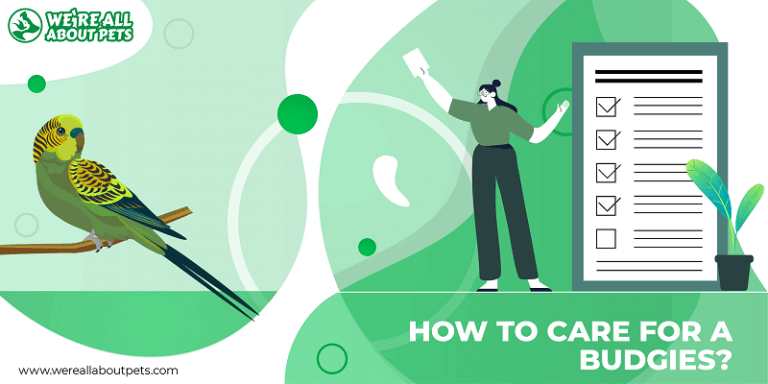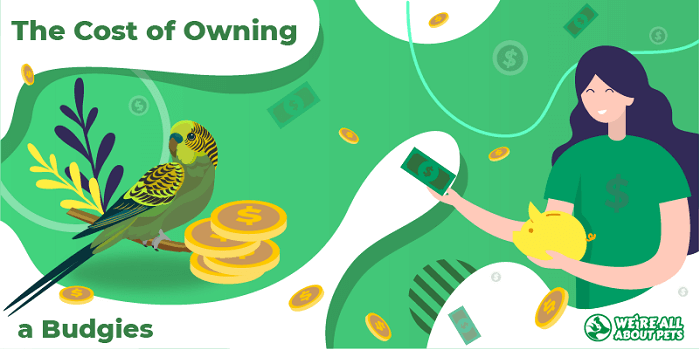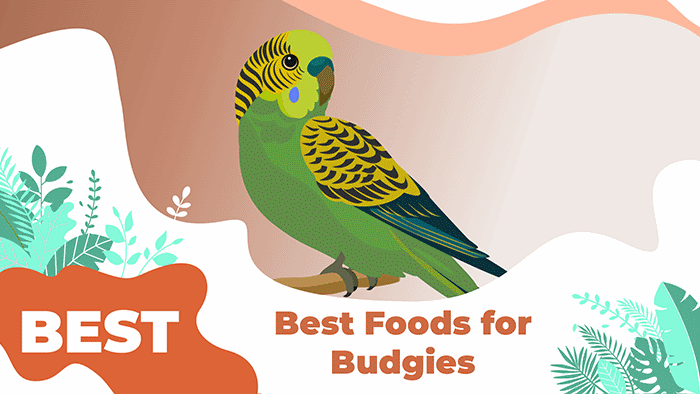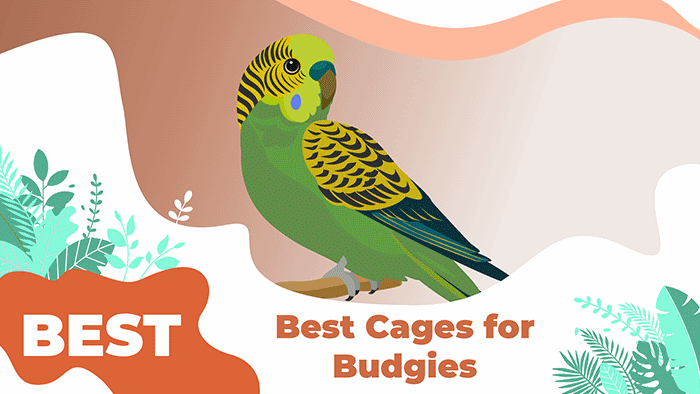How To Care For Budgies?
This page contains affiliate links. We may earn money or products from the companies mentioned in this post through our independently chosen links, which earn us a commission. Learn More
General Stats:
- Pet Type: Bird
- Size: Up to 7 inches
- Diet: Omnivore
- Lifespan: Up to 10 years
The budgerigar is a small bird native to Australia commonly kept as a pet in the United States. Alternatively called the budgie or parakeet, these little birds are playful and active.
Though they are often misrepresented as an “easy” pet to keep, budgies require a certain degree of care, as does any pet. Budgies need a healthy and balanced diet as well as adequate exercise, a safe environment, and mental stimulation to thrive.
Here’s what you need to know about proper parakeet care.
Habitat Setup For Parakeets
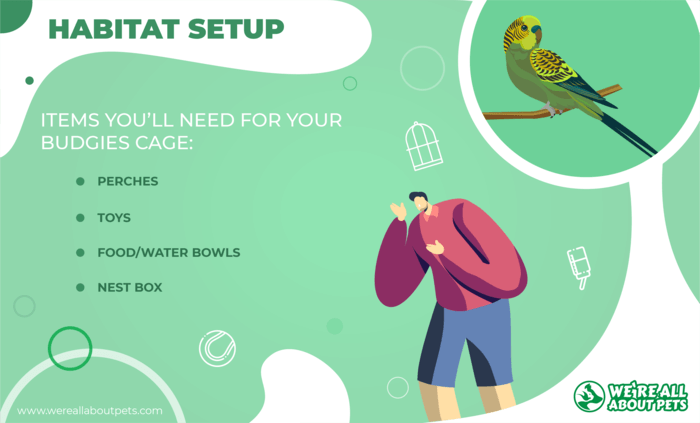
Your first task as a budgie owner is to set up your pet’s new home. A bird cage is often called an aviary and, because budgies are social birds, you should provide enough space for a group of them.
Pet shops often keep parakeets in small cages, but you need to provide enough space for your birds to exercise and move about freely. The minimum cage size for a pair of budgies is 40x20x20 inches. Make sure the bar spacing is smaller than ½ inch and it should be horizontal to facilitate climbing.
Here are some of the items you’ll need for your parakeet cage:
- Perches – Provide your parakeets with at least two perches – more for larger groups of birds. There should be at least two different thicknesses and textures, placed at different heights.
- Toys – Budgies are active birds, so provide a variety of toys for exercise and mental stimulation. These birds tend to like ladders, bells, mirrors, balls, and squeakers.
- Food/Water Bowls – Fresh water should be available at all times and you’ll need a dish for your budgie’s food. Don’t place food or water dishes directly below a perch.
- Nest Box – Though many parakeets are content to sleep on their perches, you may want to provide a nesting box – especially if you’re keeping a breeding pair.
In addition to properly outfitting your budgie’s cage, you should also think about where you’re going to put it and how you’re going to maintain it. Keep the bird cage out of direct sunlight and away from drafts and air vents. Spot-clean as needed and clean the bottom of the cage at least once a week.
Keep in mind that birds can be a little messy. You may need to clean your budgie’s food and water dishes on a daily basis – maybe more than once a day.
Parakeet Diet
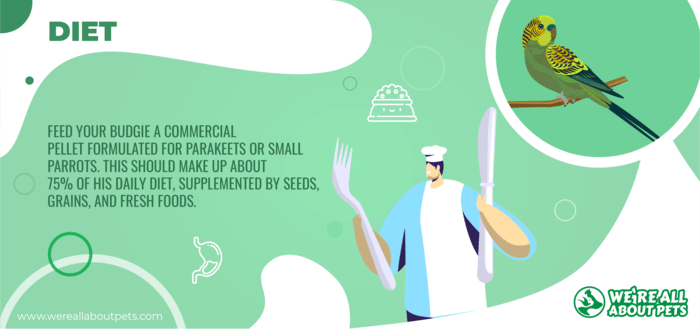
In the wild, parakeets feed primarily on grass seeds and small grains. They will also eat some fruits, berries, and vegetation. In captivity, your budgie’s diet will be largely made up of seed mix or pellets.
The most important aspect of budgie care is a healthy and balanced diet. It is particularly important for young birds to have a healthy diet, so they grow properly without developing health problems. A diet of bird seed alone isn’t nutritionally complete, so plan to offer a variety of different foods.
Here are some quick facts about the ideal budgie diet:
- Feed your budgie a commercial pellet formulated for parakeets or small parrots. This should make up about 75% of his daily diet, supplemented by seeds, grains, and fresh foods.
- Supplement your budgie’s diet with fresh foods like fresh fruits and leafy greens – offer small amounts daily and provide a variety over the course of the week.
- If you choose to feed your budgie seed mix instead of pellets, be sure it contains at least 5 types of seeds (primarily grass seeds) – grains like corn and quinoa should not be the foundation of your budgie’s diet.
- Feel free to offer your budgie small amounts of grains as treats if you’re feeding a pelleted diet – sprouted grains are best, such as quinoa, amaranth, or wheat.
- Consider providing a cuttlebone or mineral block to provide for your budgie’s calcium needs – ask your vet about supplements if your pet is nutrient deficient.
On top of your parakeet’s diet, be sure to provide unlimited access to clean water as well. Fresh fruits and vegetables provide some hydration, but water should be available at all times.
Budgie Veterinary Care
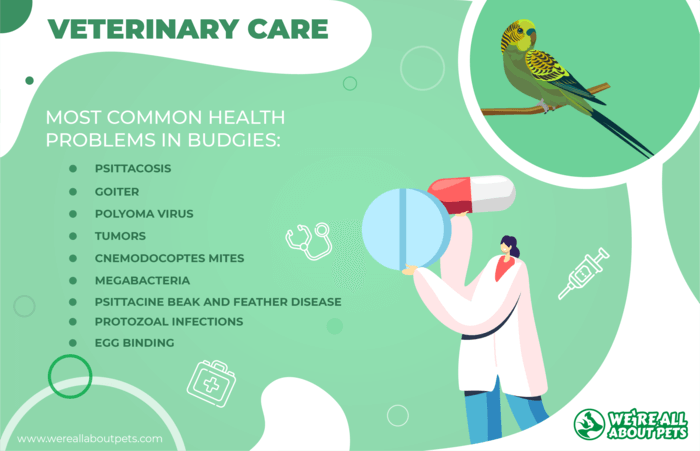
Proper care of a parakeet is not difficult, but it does require some time and attention. Find a good avian vet in your area and take your pet in for its first visit within a few weeks of bringing him to his new home. After that, your parakeet should have regular checkups every 6 to 12 months.
The benefit of regular vet visits is that it makes it easier to keep an eye on current health problems and to identify developing health issues. You should also be familiar with some of the conditions to which budgies are prone so you can recognize the signs of illness and bring them to your vet’s attention.
Here are some of the most common health problems in parakeets:
- Psittacosis
- Goiter
- Polyoma virus
- Tumors
- Cnemodocoptes mites
- Megabacteria
- Psittacine beak and feather disease
- Protozoal infections
- Egg binding
With proper care and a little luck, you shouldn’t have to worry about major veterinary expenses for your new budgie. These little birds are prone to certain issues, but if you do your job as a responsible bird owner and keep an eye on your pet’s health, you should be able to spot issues before they become too serious.
Parakeet Fun Facts
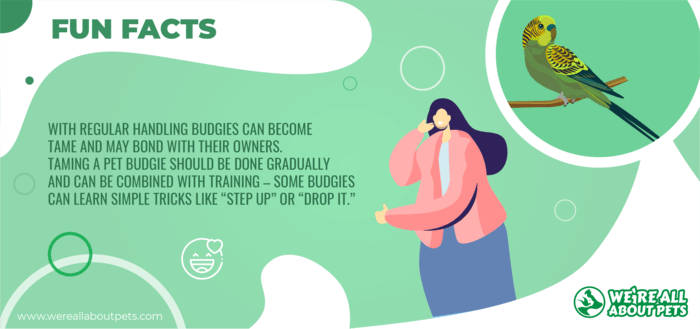
- With regular handling budgies can become tame and may bond with their owners. Taming a pet budgie should be done gradually and can be combined with training – some budgies can learn simple tricks like “step up” or “drop it.”
- There are two common types of budgies: English and American. American budgies are the smaller of the two and have sleeker plumage compared to the larger, fluffier English budgie. While all budgies are parakeets, not all parakeets are budgies.
- In the wild, budgies have a natural coloration of yellow and green. Budgies bred for the pet trade, however, tend to be blue, white, and grey in color.
- Though budgies don’t tend to be big talkers without training, they can actually learn to speak more clearly with a broader vocabulary than some larger parrots. They have gravelly-sounding voices but have a strong ability to mimic words and phrases.
- Unlike many birds, budgies and other parrots have two toes facing forward and two facing backward. Most birds have three front-facing toes and one back-facing toes.
- It can be difficult to tell males and females of the same species apart when it comes to birds, but budgies have a small tell. Budgies have a bump called a cere above the beak – the color indicates the sex (blue for male, brown for female).
Though budgies are by no means a high maintenance pet, they are not a “throwaway” bird like some have said. Just because these birds are easier to keep than some species doesn’t mean they are any less deserving of proper bird care. If you don’t know how to take care of a budgie, do some research.
Your pet budgie needs a varied diet, a suitable habitat, and plenty of interaction. Unless you can provide for a budgie’s needs, you should consider another pet.
Frequently Asked Questions
How long do parakeets live?
The average lifespan for a pet parakeet is 7 to 10 years.
How much do parakeets cost?
The cost to keep a parakeet varies depending on the number of budgies you have and the size of your cage. Budgies themselves are very affordable at the pet store, usually $10 to $35 each. You’ll spend another $100 to $250 to get the cage set up and then you’re looking at a monthly cost around $10 to $20 for food. You should also factor in the cost of a yearly avian vet visit, up to $50.
How big do budgies get?
Budgies or parakeets are fairly small birds, growing up to 7 inches in length.
What do parakeets eat?
In the wild, parakeets feed primarily on seeds and grain, though they will also eat some fruits and other vegetation. A pet parakeet diet should be founded on a high-quality seed mix or a commercial bird pellet for small birds. Be sure to feed your pet bird fresh foods like fruits and veggies as well.
Are budgies good pets?
Yes, budgies make good pets for new bird owners. Not only are they fairly small, but they are more affordable than some species. These birds still require a balanced diet and proper veterinary care, however. If you’re willing to put in the time and effort with your new pet, a budgie is a good choice.
Are budgies messy?
Parrots often have a reputation for being messy and this can be true of budgies. You’re likely to find seed and feathers scattered around the cage but having a liner on the bottom of the cage can help make cleanup easier. You should also clean the food and water bowls daily.
Where do parakeets come from?
The budgerigar or budgie is native to Australia where it lives in large flocks in the grasslands.
Do parakeets bite?
Many new bird owners like parakeets because they are small, gentle birds. Keep in mind, however, that any bird will bone when it feels threatened or afraid. Parakeets can become territorial when kept in breeding pairs but you shouldn’t have to worry about it if you handle your bird often and care for it properly.
Do budgies sleep?
Like most birds, parakeets tend to be more active during the day than at night. This species does not, however, require 10 hours of consecutive sleep like some parrots. Budgies will often fall into the same sleep schedule as their owner and they tend to sleep on their perches.
How long are parakeets pregnant for?
Parakeets are egg layers and they generally have 4 to 8 eggs per clutch. These small birds have 2 to 3 clutches per year in the wild but can have more in captivity. Female parakeets can lay eggs without a male present, but they won’t be fertilized. Fertilized eggs need to incubate 17 to 20 days to hatch.






